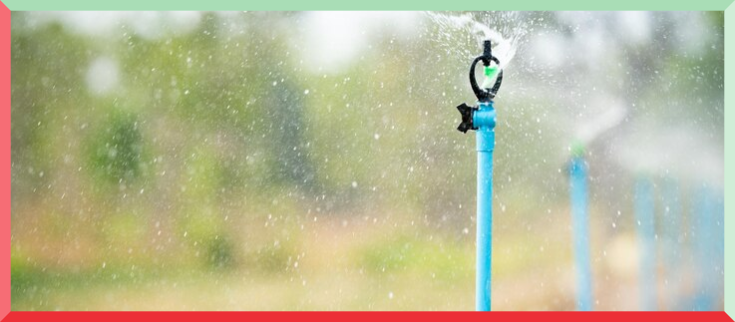
For a green garden, a farm, or a playfield, sprinkler irrigation is essential.
There are several types of sprinklers used for different purposes. However, if the sprinkler irrigation system is not maintained efficiently, it can result in water wastage and uneven water distribution, which can adversely affect plant growth.
To optimize your sprinkler irrigation system, follow these key tips.
Make Sure There Are No Leakages
Leakage in the pipe delivering water to the sprinkler can hinder the efficiency of the sprinkler system.
There are various reasons for leaks. Make sure to regularly check the pipe for any leaks and use proper glue to secure the pipe. If there is a significant crack in the pipe causing the leakage, replace it with a new one.
If you’re using an extension or manually setting up a sprinkler system, ensure that washers are used to connect two pipes, or replace old ones with new ones.
Choosing the Right Sprinklers
There are many types of sprinkler heads available on the market.
Choose the best one that fits your watering needs and matches your landscape.
Also, consider the type of plants or grass you will be cultivating.
Ensure Sensors and Timers Work Properly
If you’re using sensors for automatic irrigation then; do check them regularly to ensure that they are working properly. Incorrect irrigation cycles can occur if there are any issues with the sensors.
Not only sensors, but if you’re also using a timer or an automatic starter, it’s important to check if they are functioning properly.
Maintaining the Sprinkler Head
No irrigation is needed during the rainy season, so to prepare for the next hot summer, you should clean the sprinkler nozzles and ensure there is no debris. Additionally, check that the washers used in the sprinkler heads fit properly.
This tip is especially important for those who use metal sprinklers rather than plastic and automated garden sprinklers.
Ensure Sprinklers Are Set to Provide Head-to-Head Coverage
When using multiple sprinklers, ensure that each sprinkler sprays water into the adjacent sprinkler zone.
Meaning that every sprinkler you set up has to spray the water into the next and its previous sprinkler water zone; all the sprinkler water zones intersect with each other to give a proper Head to Head coverage.
Direct Sprinkler to Water the Root Zone
Never set the sprinkler to spray water to the trunk or the leaves of the plant. Insted, aim for the furthest point of your tree or shrub’s canopy, that’s the root zone. Adjust your sprinkler system to hit the ground underneath the canopy.
Vary Watering By the Plant Type
Utilize the sprinkler system to provide water according to the specific needs of each plant or type of grass.
Different types of grass and plants in landscaped beds generally require varying amounts of water.
Consult with a trained irrigator, landscape professional, or university extension office to establish separate watering zones based on the specific plant needs for your area and the time of year.
Regulator Check On Motor
Most of the time, for sprinkler irrigation Motors are used. If you’re using one, it’s important to perform regular checkups.
Even if you’re using a Monoblock Motor, pay extra attention to it. On hot summer days, when water is draining, the motor’s ink filler can get filled with debris and stones, leading to reduced water pressure and weak sprinkler performance.
Also, ensure that you have enough water to start the motor.
Measure Water Pressure
If water comes out as more of a mist than a spray from a sprinkler head, the wind can carry the water droplets away, preventing them from reaching your plants. This can compromise the efficiency of the sprinkler system.
You can resolve this issue with a water pressure regulator or booster pump.
Water Early or Late
This tip applies not only to sprinkler irrigation but also to watering cans or garden hoses. Watering in the early morning or late at night is the best time for irrigation.
Watering in the afternoon, when the sun is at its hottest, can cause the soil to dry out quickly before evening, when lower temperatures and wind speeds reduce evaporation.
Develop a Sprinkler System Maintenance Schedule
To make sure the sprinkler system works properly, do have a maintenance schedule at least once a season.
The sprinkler system consists of small moving parts, which means there are multiple ways it can malfunction. Developing a maintenance schedule can help you avoid malfunctions and ensure the long-term functionality of your sprinkler system.
You can choose to check the sprinkler system on your own or seek the assistance of a professional.
Final Word…
By implementing these strategies, you can enhance sprinkler efficiency, reduce water waste, and ensure healthy plant growth.
Maximizing efficiency also means not only saves water but also extends the lifespan of your irrigation setup.

Leave a Reply